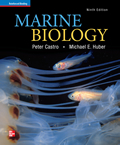
Marine Biology (Castro), 9th EditionChapter 7: Marine Animals Without a BackboneFor Further ReadingDennis, C., 2003. Close encounters of the jelly kind. Nature, vol. 426, 2 November, pp. 12–14. Deep-diving submarines discover amazing jellyfishes and comb jellies. Duff y, J. E., 2003/2004. Underwater urbanites. Natural History, vol. 112, no.-10, December/January, pp. 40–45. Snapping, or pistol, shrimps that live in sponges have evolved complex societies similar to those of bees. Fortey, R. A., 2004. The lifestyles of the trilobites. American Scientist, vol. 92, no.-5, September–October, pp. 446–453. A surprisingly high number of species of trilobites, a group of extinct arthropods, inhabited the oceans 450 million years-ago. Levy, S., 2004. Crabs in space. New Scientist, vol. 181, no. 2438, 13 March, pp. 42–43. Cells in the blood of horseshoe crabs help space scientists detect earth microbes in space probes. McClintock, J., 2004. This is your ancestor. Discover, vol. 25, no. 11, November, pp. 64–69. Molecular biologists have provided additional evidence that sponges are close to the ancestors of all animals, including us. Summers, A., 2004. How a star avoids the limelight. Natural History, vol. 113, no.-4, May, pp. 32–33. The eyes of echinoderms, though seemingly simple, have a vital function. Summers, A., 2004. Knockout punch. Natural History, vol. 113, no. 6, July/ August, pp. 22–23. The claws of mantis shrimps are powerful weapons that conceal an intricate mechanism. Brooke, N. M. and P. W. Holland, 2003. The evolution of multicellularity and early animal genomes. Current Opinion in Genetics and Development, vol. 13, no. 6, pp. 599–603. Burke, W. A. B., 2002. Cnidarians and human skin. Dermatologic Therapy, vol. 15, no. l, pp. 18–25. Corson, T., 2004. The Secret Life of Lobsters: How Fishermen and Scientists Are-Unraveling the Mysteries of our Favorite Crustacean. HarperCollins, New York. Fautin, D. G., 2002. Reproduction of Cnidaria. Canadian Journal of Zoology, vol. 80, no. 10, pp. 1735–1754. Halanych, A. M., 2004. The new view of animal phylogeny. Annual Review of Ecology, Evolution, and Systematics, vol. 35, pp. 229–256. Hart, M. W., 2002. Life history evaluation and comparative developmental biology of echinoderms. Evolution and Development, vol. 4, no. 1, pp. 62– 71. Lawrence, A. J. and J. M. Soame, 2004. The effect of climate change on the reproduction of coastal invertebrates. Ibis, vol. 146 (suppl.), no. s2, pp. 29–39. Martin, V. J., 2002. Photoreceptors of cnidarians. Canadian Journal of Zoology, vol. 80, no. 10, pp. 1703–1722. Rouse, G. W. and F. Pleijel, 2003. Problems in polychaete systematics. Hydrobiologia, vol. 496, no. 1–3, pp. 175–189. Thurman, C., 2004. Unravelling the ecological significance of endogenous rhythms in intertidal crabs. Biological Rhythm Research, vol. 35, no. 1–2, pp.-43–67. Watson, G. J., M. G. Bentley, S. M. Gaudron and J. H. Herdage, 2003. The role of chemical signals in the spawning induction of polychaete worms and other marine invertebrates. Journal of Experimental Marine Biology and Ecology, vol. 294, no. 2, pp. 169-187. http://seawifs.gsfc.nasa.gov/squid.html |  |















